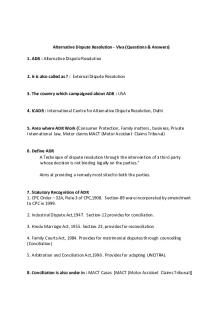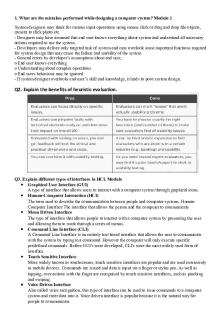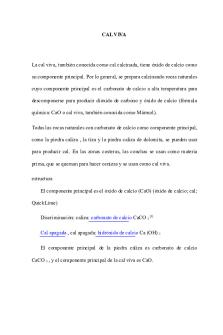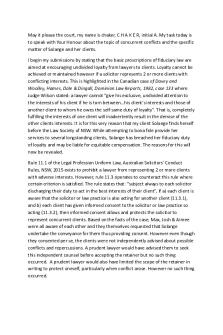Viva Voce Assessment PDF

| Title | Viva Voce Assessment |
|---|---|
| Course | Professional Responsibility and Legal Ethics |
| Institution | Western Sydney University |
| Pages | 7 |
| File Size | 124.8 KB |
| File Type | |
| Total Downloads | 6 |
| Total Views | 142 |
Summary
Viva Voce- cost agreements/ assessments...
Description
Viva Voce- Cost Disclosure and Cost agreements May it please the court, my name is, , I appear for Naham of N&F Law in this local court hearing. Naham has three allegations of misconduct against her and I will make submissions about those to you. Your Honour, the fist issue is concerning Zahir and the issue of cost disclosure and cost agreement. Your Honour, In accordance to s 174(4) a disclosure of costs is not required to be made under subsection (1) if the amount does not exceed $750. As asserted in Clause 18 of Schedule 4 to the Legal Profession Uniform Law (NSW) until relevant Uniform Rules take effect, the lower threshold is $750 and the higher threshold is $3000. In the case of Equuscorp pty ltd v Wilmoth field Warne (No. 4) VSC (Victoria Supreme Court) 28 at 7 - 21 it is indicated that $400 is the “normal” hourly rate charged Therefore, I submit Naham was not required to provide Zahir with a cost disclosure as the amount did not exceed $750. Zahir was provided with a receipt and left satisfied. Your Honour I will now address the second issue concerning KADIN and whether the cost disclosure document and cost agreement provided by N&F Law are valid: Your Honour, s 172(1) of the Legal Profession Uniform Law (NSW) 2015 asserts that A law practice must, in charging legal costs, charge costs that are no more than fair and reasonable in all the circumstances and that in particular are— (a) proportionately and reasonably incurred; and (b) proportionate and reasonable in amount. Your Honour, In Accordance with Legal Profession Uniform Law 2015 (NSW) s174(1) (a) it is a requirement to disclose the basis on which the costs will be calculated in the matter and an estimate of the total legal costs. The Legal Services Council expresses its view that an estimate of the total legal costs in a matter, as required by section 174(1)(a) of the Legal Professional Uniform Law, is a reasonable approximation of the total costs that a client is likely to have to pay in the matter for which instructions have been given, expressed as a single figure, from time to time (the estimate). This is established within the case of Garbutt v Edwards [2006] 1 All ER 553 that Giving an estimate is not a mere formality, but requires due and detailed consideration. And further in Casey v Quabba (2005) QSC (Queensland Supreme Court) 356 at 39 where it was determined by Justice Jones that an estimation between $0 and $250,000 is not a genuine attempt to inform the client. Your Honour I submit, Naham failed to provide Kadin with all of the required information under s174(1)(a) of the Legal Profession Uniform Law 2015. As
demonstrated by the legal services council guideline it is more appropriate to give a single figure and advise the client that the estimate may vary to some extent. This is further reiterated by professor Dal Pont in his text Law of Costs at 2.26 : stating ‘Any costs estimate, including an estimate of its increase, must therefore be realistic, requiring due and detailed consideration’. He continues, ‘the process of estimation forces the lawyers to address the likely steps in the matter, and what falls within and outside those steps’. It is evident Nahim neglected to provide thorough consideration to the matter, and failed to inform the client as required. The definition of total legal costs in this context includes professional fees, any disbursements and GST, which should be separately identified, but not interest: Legal Professional Uniform Law section 6. In the circumstance that the legal costs in a matter are not likely to exceed $3000 the law practice may provide a short alternative cost disclosure rather than a full cost disclosure as asserted in the office of the legal services commissioner fact sheet 2. Therefore your honour I submit pursuant to s174(5) the alternative cost disclosure should not have been provided to Kadin, and a disclosure in accordance with s174(1) was required, as the projected legal costs of “$2000 to $200,000” exceeds the higher threshold ($3000) as specified in the Legal Profession Uniform Law (NSW) Clause 18 of Schedule 4. Furthermore, your honour I bring your attention to s174(2) of the Legal Profession Uniform Law 2015 which asserts that additional information must be provided. This information includes the clients right to negotiate a cost agreement. Subsection (1) (b) highlights that the client must also be provided with a sufficient and reasonable amount of information about the impact of the change on the legal costs that will be payable to allow the client to make informed decisions about the future conduct of the matter. Your Honour I submit that Naham failed to provide this required additional information to Kadin, as she only informed him of a vague estimate and neglected her obligation to advise Kadin of his rights. Additionally, your honour, s174(3) outlines that If a disclosure is made under subsection (1), the law practice must take all reasonable steps to satisfy itself that the client has understood and given consent to the proposed course of action for the conduct of the matter and the proposed costs. Your honour I submit that Nahim failed to comply with this section as there were no reasonable steps taken to ensure the clients full understanding of the proposed costs. It is at all times important that the matter for which the estimate is required is clearly defined and understood by both the law practice and their client and in particular it should be explained to a client that the estimate is not a fixed fee quotation. In accordance with s178(1) of the LPUL (2015) if a law practice contravenes the disclosure obligations of this part the cost agreement is void,therefore Kadin is not required to pay the legal costs until they have been assessed or any costs dispute has been determined by the designated local regulatory authority; and N&F Law
must not commence proceedings against the client until the costs have been assessed. If proceedings are commenced by N&F Law prior to assessment the practice may be subject to disciplinary proceedings for unsatisfactory professional conduct. Your Honour I will now address the third issue concerning RIMA, the issue being whether rima is liable to pay the costs, after they had been increased. Your Honour I make specific reference to Section 175(2) of the Legal Profession Uniform Law 2015 (NSW)
If a law practice (the first law practice) retains or intends to retain another law practice (the second law practice) on behalf of a client, the second law practice is not required to make a disclosure to the client under section 174, but must disclose to the first law practice the information necessary for the first law practice to comply with subsection (1).
That is, it is the solicitor’s duty to disclose to the client the basis on which the legal costs will be calculated and an estimate of total legal costs in relation to the barrister at the time the barrister is engaged or as soon as practicable. Your Honour, When a barrister is engaged by a solicitor, the usual position is that the solicitor is liable for the counsel’s fee, and then the client becomes liable to indemnify the solicitor for those fees (assuming the barrister was briefed on the client’s instructions). This position is stated in the case of Dimos v Hanos & Elgaln [2001] VSC (Victoria Supreme Court) 173: ‘In the absence of any contrary evidence, the retention of the barrister would result in a contract between the barrister and the solicitor.’[1] Your Honour as asserted by the office of the legal services commissioner fact sheet 2, there is no requirement that a disclosure be signed by a client. It is not unusual for unforeseen costs to arise as a matter progresses. A law practice must disclose any significant change to anything previously disclosed, providing information disclosing the change and its impact on legal costs. Law practices must, after making costs disclosure, take steps to ensure a client understands, and has given consent to, the proposed course of action for the conduct of the matter and the proposed costs. The client should enquire about other expenses that are likely to arise. These expenses are called disbursements. Examples of disbursements include barristers’ fees. The client pays for disbursements either directly or as part of the law practice’s bill. It is often difficult to predict the final cost of legal services because most matters involve some unknown factors. Your Honour I submit that the standard cost disclosure provided by Majid to Naham then to the client Rima is valid and was provided in accordance with the standard disclosure requirements of s174(1) of the Legal Profession Uniform Law 2015
If a law practice makes full disclosure in accordance with the main disclosure requirements it must take all reasonable steps to ensure the client has understood and given consent to the course of action and the proposed costs.7 Your Honour in accordance with s180 of the Legal Profession Uniform Law (NSW) (2) A costs agreement must be written or evidenced in writing. (3) A costs agreement may consist of a written offer that is accepted in writing or (except in the case of a conditional costs agreement) by other conduct. Under general contract law, acceptance must be unequivocal and must be communicated to the offeror; it can be oral, in writing or by conduct. The burden of establishing that a client’s conduct was intended to be acceptance of a costs agreement will lie with the law practice seeking to enforce the contract. Your Honour in the case of Swaab v Sayed 2013 NSWSC (Supreme Court) 887 at 28 Justice Kunc found that continuing to instruct the law practice and paying some of its invoices, as acceptance of the offer set out in the terms of the cost agreement. Your Honour I submit that there was a fortnight of court proceedings that had been completed on Rimas behalf and therefore by continuing to instruct the law practice her conduct acted as acceptance for the cost agreement. Your Honour the Legal Profession Uniform General Rules 2015 s72A stipulates A costs agreement will not be void if the law practice had:
taken reasonable steps to comply with their disclosure requirements; and
within 14 days of becoming aware of a contravention, rectified it by providing the necessary costs disclosure information. The relevant authority, a costs assessor, court or tribunal will also need to be satisfied that:
the contravention was not substantial; and
it would not be reasonable to expect that the client would have made a different decision had they known about the change in the costs from the outset
Your Honour, although Majid took 14 days to disclose to Naham that costs had increased to $70,000, Naham took reasonable steps, within an appropriate timeframe, to disclose to Rima the the change and its impact on legal costs. When establishing the reasonableness of an increase in costs there are various factors that need to be considered as asserted in s172(2) of the Legal Profession Uniform Law NSW 2015. And further reiterated in Council of the Law Society v Helby (2018) NSW civil and administrative tribunal occupational division decision 182 at paragraph 23. 23. Factors that inform this consideration include the amount at which the costs in question was or would likely to be assessed, the difficulty of the case, the novelty or
complexity of the legal issues, the experience of the lawyer, the quality of his or her work, the amount of time spent on the matter, the responsibility involved, the amount or value of the subject matter in issue, and any costs agreement that has been entered into as asserted in D'Alessandro v Legal Practitioners Complaint Committee (1995) 15 WAR (Western Australian Reports 198 at 214. Your honour I submit that the cost increase was reasonable after considering the amount of time spent on the matter, complexity and quality of work. Therefore your honour Rima is liable for the costs however can apply for a cost assessment in accordance with section 198 of the Legal Profession Uniform Law 2015.
Your Honour if that pleases the court that concludes my submissions today.
Rima can apply for a cost assessment in accordance with section 198 of the Legal Profession Uniform Law 2015. 199 Costs assessment (1) Assessments of legal costs are to be conducted by costs assessors, and are to be conducted in accordance with this Part, the Uniform Rules and any applicable jurisdictional legislation. (2) On a costs assessment, the costs assessor must— (a) determine whether or not a valid costs agreement exists; and (b) determine whether legal costs are fair and reasonable and, to the extent they are not fair and reasonable, determine the amount of legal costs (if any) that are to be payable. Note A costs agreement can be void under section 178 or 185
Furthermore the president of the NSW Bar Association, David Bennett QC said: “First rule; there is no rule as fees are entirely a matter of negotiation between the barristers and their solicitors or clients. Second rule is that the basis of the charging needs to be disclosed in advance. 3rd rule is the bargain any reasonable cancellation fee so long as one does in advance. 4th rule is that must not be unreasonably large, and take into account the fees of barrister and his/her seniority and eminence. Therefore excessive fees can amount to professional misconduct or unsatisfactory professional conduct”.
OVER CHARGING: Veghelyi v the Law Society of NSW In this case the appellant was found guilty of professional misconduct by the tribunal and struck off the rolls, on the basis that he charged his clients overcharged and used clients money without authority for professional costs. Mahoney JAstated that “solicitors are, informed or in a position to inform themselves, of what workmay be required and what are fair and reasonable charges. They are in a position of advantage and trustis placed in them. Clients are entitled to be protected against the abuse of such an advantage. In factthat advantage has been misused which may, in particular case, warrant what the solicitor does beingcategorized as profession misconduct”.
CASE: Hearing dates: 1 August 2017 Date of orders: 08 November 2018 Decision date: 08 November 2018 Jurisdiction: Occupational Division
Before: Craig QC ADCJ Principal Member Naida Isenberg Senior Member B Thomson General Member Parties: The Council of the Law Society of New South Wales (Applicant) Christopher Vincent Helby (Respondent) Decision:(1) The Respondent Christopher Vincent Helby be and is hereby reprimanded. (2) Order that the Respondent Christopher Vincent Helby pay a fine in the sum of $5000.
Facts:...
Similar Free PDFs

Viva Voce Assessment
- 3 Pages

Viva Voce Assessment
- 7 Pages

Viva voce Final
- 19 Pages

Viva Voce Assignment
- 3 Pages

Viva-voce-semiconductors
- 4 Pages

VIVA VOCE - Lecture notes abcd
- 1 Pages

Case list - Viva voce case list
- 3 Pages

ADR Viva QS - ADR VIVA
- 7 Pages

HMI VIVA - HMI Viva Peparation
- 9 Pages

CAL VIVA - Resumen sobre cal viva
- 14 Pages

VIVA Notes
- 30 Pages

VIVA preparation
- 2 Pages

Java viva
- 13 Pages

Python viva
- 4 Pages

Viva questions
- 6 Pages
Popular Institutions
- Tinajero National High School - Annex
- Politeknik Caltex Riau
- Yokohama City University
- SGT University
- University of Al-Qadisiyah
- Divine Word College of Vigan
- Techniek College Rotterdam
- Universidade de Santiago
- Universiti Teknologi MARA Cawangan Johor Kampus Pasir Gudang
- Poltekkes Kemenkes Yogyakarta
- Baguio City National High School
- Colegio san marcos
- preparatoria uno
- Centro de Bachillerato Tecnológico Industrial y de Servicios No. 107
- Dalian Maritime University
- Quang Trung Secondary School
- Colegio Tecnológico en Informática
- Corporación Regional de Educación Superior
- Grupo CEDVA
- Dar Al Uloom University
- Centro de Estudios Preuniversitarios de la Universidad Nacional de Ingeniería
- 上智大学
- Aakash International School, Nuna Majara
- San Felipe Neri Catholic School
- Kang Chiao International School - New Taipei City
- Misamis Occidental National High School
- Institución Educativa Escuela Normal Juan Ladrilleros
- Kolehiyo ng Pantukan
- Batanes State College
- Instituto Continental
- Sekolah Menengah Kejuruan Kesehatan Kaltara (Tarakan)
- Colegio de La Inmaculada Concepcion - Cebu
